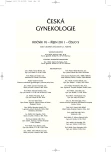Follow-up after conservative surgery for cervical precancer lesions
Authors:
J. Sláma
Authors‘ workplace:
Onkogynekologické centrum, Gynekologicko-porodnická klinika VFN a 1. LF UK, Praha, přednosta prof. MUDr. A. Martan, DrSc.
Published in:
Ceska Gynekol 2011; 76(5): 339-342
Overview
Objective:
To summarize current knowledge of postoperative follow-up after conservative surgical treatment of cervical precancer lesions.
Design:
Review article.
Setting:
Oncogynecological center, Department of Gynecology and Obstetrics, General Faculty Hospital and 1st Medical School of Charles University, Prague.
Methods and results:
Residual or recurrent disease is diagnosed in a small amount of women after conservative surgical treatment of cervical precancer lesions. Series of consecutive negative findings are necessary prior to return back to routine screening. Most sensitive marker for residual and recurrent disease is detection of HPV infection. Negative predictive value of HPV testing is significantly higher as compared with negativity of surgical margins or negative Pap smear.
Conclusions:
Combination of HPV and Pap smear negativity shows nearly absolute negative predictive value for oncologically relevant finding in postoperative management.
Key words:
AIS, CIN, cervical cancer, Pap smear, HPV test, conization, postoperative follow-up.
Sources
1. Arbyn, M., Paraskevaidis, E., Martin-Hirsch, P., et al. Clinical utility of HPV-DNA detection: triage of minor cervical lesions, follow-up of women treated for high-grade CIN: an update of pooled evidence. Gynecol Oncol, 2005, 99, 3 Suppl. 1, p. S7-11.
2. Dušková, J., Dvořáčková, J., Dvořák, V., et al. Konsenzus pro řešení abnormálních nálezů ve screeningu cervikálních karcinomů. Modern Gynekol Porod, 2010, 19, s. 251-259.
3. Ghaem-Maghami, S., Sagi, S., Majeed, G., et al. Incomplete excision of cervical intraepithelial neoplasia and risk of treatment failure: a meta-analysis. Lancet Oncol, 2007, 8, p. 985-993.
4. Chen, Y., Lu, H., Wan, X., et al. Factors associated with positive margins in patients with cervical intraepithelial neoplasia grade 3 and postconization management. Int J Gynaecol Obstet, 2009, 107, p. 107-110.
5. Jordan, J., Martin-Hirsch, P., Arbyn, M., et al. European guidelines for clinical management of abnormal cervical cytology, Part 2. Cytopathology, 2009, 20, p. 5-16.
6. Kim, YT., Lee, JM., Hur, SY., et al. Clearance of human papillomavirus infection after successful conization in patients with cervical intraepithelial neoplasia. Int J Cancer, 2010, 126, p. 1903–1909.
7. Lu, CH., Liu, FS., Kuo, CJ., et al. Prediction of persistence or recurrence after conization for cervical intraepithelial neoplasia III. Obstet Gynecol, 2006, 107, p. 830-835.
8. Martin-Hirsch, P., Paraskevaidis, E., Bryant, A., et al. Surgery for cervical intraepithelial neoplasia. Cochrane Database Syst. Rev., 2010, 16, p. CD001318.
9. Moniak, CW., Kutzner, S., Adam, E., et al. Endocervical curettage in evaluating abnormal cervical cytology. J Reprod Med, 2000, 45, p. 285-292.
10. Ondruš, J. Doporučené postupy při diagnostice a terapii CIN. Gynekolog, 1998, 3, s. 104-106.
11. Paraskevaidis, E., Arbyn, M., Sotiriadis, A., et al. The role of HPV DNA testing in the follow-up period after treatment for CIN: a systematic review of the literature. Cancer Treat Rev, 2004, 30, p. 205-211.
12. Poynor, EA., Barakat, RR., Hoskins, WJ. Management and follow-up of patients with adenocarcinoma in situ of the uterine cervix. Gynecol Oncol, 1995, 57, p. 158-164.
13. Prendiville, W. Treatment of CIN: what are the risks? Cytopathology, 2009, 20, p. 145-153.
14. Reich, O., Lahousen, M., Pickel, H., et al. Cervical intraepithelial neoplasia III: long-term follow-up after cold-knife conization with involved margins. Obstet Gynecol, 2002, 99, p. 193-196.
15. Salani, R., Puri, I., Bristow, RE. Adenocarcinoma in situ of the uterine cervix: a metaanalysis of 1278 patients evaluating the predictive value of conization margin status. Am J Obstet Gynecol, 2009, 200, p. 182.e1-182.e5.
16. Soutter, WP., Sasieni, P., Panoskaltsis, T. Long-term risk of invasive cervical cancer after treatment of squamous cervical intraepithelial neoplasia. Int J Cancer, 2005, 118, p. 2048-2055.
17. Strander, B., Andersson-Ellsrom, A., Milsom, I., et al. Long term risk of invasive cancer after treatment for cervical intraepithelial neoplasia grade 3: population based cohort study. BMJ, 2007, 335, p. 1077.
18. Verguts, J., Bronselaer, B., Donders, G., et al. Prediction of recurrence after treatment for high-grade cervical intraepithelial neoplasia: the role of human papillomavirus testing and age at conisation. BJOG, 2006, 113, p. 1303-1307.
19. Wright, TC jr., Massad, LS., Dunton, CJ., et al. 2006 consensus guidelines for the management of women with cervical intraepithelial neoplasia or adenocarcinoma in situ. Am J Obstet Gynecol, 2007, 197, p. 340-345.
20. Zielinski, GD., Bais, AG., Helmerhost, TJ., et al. HPV testing and monitoring of women after treatment of CIN 3: review of the literature and meta-analysis. Obstet Gynecol Surv, 2004, 59, p. 543-553.
Labels
Paediatric gynaecology Gynaecology and obstetrics Reproduction medicineArticle was published in
Czech Gynaecology

2011 Issue 5
Most read in this issue
- Fetal hypotrophy dopplerometry
- Current classification of malignant tumours in gynecological oncology – part II
- Single embryo transfer – possibilities and limits
- Perineal audit: reasons for more than one thousand episiotomies
